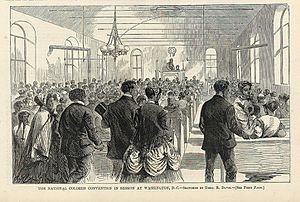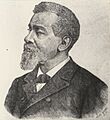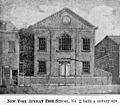George T. Downing facts for kids
Quick facts for kids
George T. Downing
|
|
|---|---|
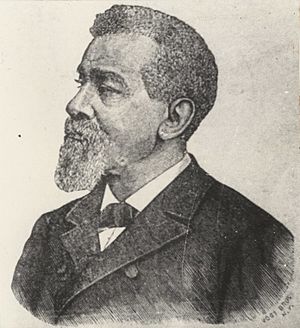 |
|
| Born | December 30, 1819 |
| Died | July 21, 1903 (aged 83) |
| Resting place | Island Cemetery, Newport, Rhode Island |
| Alma mater | Hamilton College |
| Occupation | Abolitionist, entrepreneur, restaurateur, caterer |
| Political party | Republican |
George T. Downing (born December 30, 1819 – died July 21, 1903) was an important leader in the fight for civil rights for African Americans. He was also a very successful businessman. He owned restaurants and catering businesses in New York City, Newport, Rhode Island, and Washington, D.C..
Downing's father was also a successful businessman. He sold oysters and provided catering services to rich clients. From the 1830s until slavery ended, George Downing helped enslaved people escape to freedom through the Underground Railroad. He even used his restaurant as a safe place for them to rest. He made Newport, Rhode Island, his home and worked for over 10 years to make public schools in Rhode Island open to all students, regardless of race. During the American Civil War (1861–1865), Downing helped recruit African-American soldiers to fight for the Union.
After the war, Downing moved to Washington, D.C. There, he managed the restaurant for the United States House of Representatives for 12 years. He was a key member of the Colored Conventions Movement, which worked for black rights. He also supported women's rights. He became good friends with Senator Charles Sumner and was with him when he passed away. Later in his life, Downing returned to Rhode Island. He continued to be a community leader and a strong voice for civil rights.
Contents
Early Life and Education
George Thomas Downing was born in New York City on December 30, 1819. His parents were Thomas Downing and Rebecca (West). His father, Thomas, was born in Virginia in 1791. Thomas's parents had been freed from slavery.
Thomas Downing left Virginia as a young man. He moved north to Philadelphia, where he married Rebecca West. By 1819, they had moved to New York. George was one of their five children.
George's father, Thomas, started by growing oysters. By 1825, he bought a restaurant in Manhattan. He made it a fancy oyster house that attracted powerful businessmen. Famous visitors like Charles Dickens even came to his restaurant. Thomas Downing was known for sending American oysters to Queen Victoria in England. She sent him a special gold watch in return. The Downing family was part of St. Philip's Episcopal Church, the first African-American Episcopal church in New York City.
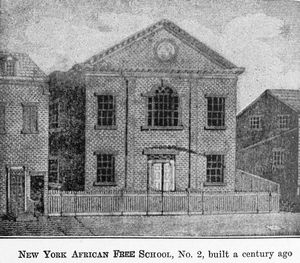
George's parents believed education was very important. George and his brothers went to school in New York City. George first attended a school on Orange Street. Then he studied at the Mulberry Street School, also known as the African Free School. As a child, George was known for protecting other black students from harassment.
Because his father was well-known, George had many special experiences. For example, he met Lafayette, a French hero of the American Revolution. When George was 14, he started a student group. They decided not to celebrate the Fourth of July. They felt it was wrong to celebrate freedom when black people in the U.S. were not yet equal. Many of his classmates in this group became important leaders later, including James McCune Smith and Henry Highland Garnet. As a young man, Downing also started working for the Underground Railroad. He later attended Hamilton College in New York.
Family Life
On November 24, 1841, George Downing married Serena Leanora de Grasse. Serena had attended Clinton Seminary in New York. Her father, George de Grasse, was born in India. He was believed to be the son of a French naval officer and an Indian woman. This officer, François Joseph Paul de Grasse, was a hero of the American Revolution. He helped the American forces win at Yorktown.
Serena's father, George de Grasse, moved from France to New York City. There, he married Maria van Surley. George and Maria made sure all their children were educated. Serena's brother, John van Salee de Grasse, became the first African-American man to get a medical degree in the United States.
George and Serena Downing had ten children together.
Business Career
In 1842, Downing started his own catering business in New York City. His work connected him with many of the city's richest families, like the Astors and Kennedys. His success allowed him to open a summer business in Newport, Rhode Island. He eventually moved to Newport in 1848. A street in Newport was later named Downing Street in his honor.
In 1849, Downing bought a large property in Newport. In 1854, he built the Sea Girt Hotel. Sadly, it burned down in 1860, possibly due to arson. He replaced it with a building called Downing Block. He rented part of this building to the government to be used as a hospital.
After the Civil War, in 1865, Downing moved to Washington, D.C. He was encouraged by a U.S. Representative. He managed the restaurant for the House of Representatives for 12 years. In 1877, he moved back to Newport and retired in 1879.
Fighting for Civil Rights
Working Against Slavery
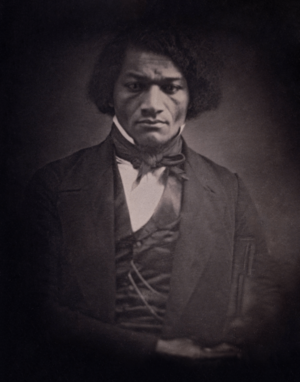
Downing was a very important leader in the movement to end slavery in New York. He helped start the American Anti-Slavery Society in 1833. Along with Frederick Douglass, Downing strongly opposed the American Colonization Society. This group wanted to send free black Americans to a colony in Africa called Liberia. Downing and his friends argued that black people should have equal rights right here in the United States. In 1841, Downing was beaten for trying to ride a train that was only for white people.
In 1847, he began working for equal education for black children. He became a member of the first board of trustees for a society that promoted education for black children in New York. When he moved to Rhode Island, he also worked to integrate public schools there.
In June 1850, Downing helped form the American League of Colored Laborers. This group was a union for former slaves working in New York City. He was also part of a group called the Committee of Thirteen. This committee fought against the Fugitive Slave Law of 1850. This law made it easier to capture and return escaped slaves. Downing helped many escaped slaves pass through New York City to freedom. He disliked this law so much that he refused to shake the hand of former President Millard Fillmore, who had signed the law.
Downing was an agent for the Underground Railroad in New York. His Oyster House restaurant was a secret stop on the route to freedom. He worked with other famous abolitionists like David Ruggles and James McCune Smith.
Downing also worked for civil rights in Rhode Island and New England. When an escaped slave named Anthony Burns was jailed in Boston in 1854, Downing protested. He argued for Burns' freedom. Downing also pushed the Rhode Island government to integrate public schools. He started a protest campaign in 1857, and it finally succeeded in 1866.
During the Civil War
As the Civil War got closer, Downing became a central figure in the civil rights movement. He led the Convention of Colored Citizens in Boston in 1859. In 1860, Downing helped organize a meeting in Boston to honor John Brown, an abolitionist who fought against slavery. This meeting faced strong opposition, and a mob tried to stop it. They had to move the meeting to a church, where they were protected by police.
During the Civil War (1861–1865), Downing was asked to help recruit African Americans into the Union Army. He met with the governor of Massachusetts and got a promise that black troops would be treated equally. After that, he began recruiting.
In October 1864, Downing was an important delegate at the Syracuse Colored Convention. He had often disagreed with leaders like Martin Delany who thought black people should leave the U.S. and form their own nation. Frederick Douglass was president of the convention and tried to keep peace between these different groups.
After the War: Reconstruction
In 1867, Downing spoke at a meeting about equal rights. He asked if people would support black men getting the right to vote before women. This question caused some disagreements within the group. However, Downing continued to support women's rights. At a convention in Washington, D.C., in 1869, he was a strong supporter of women's rights.
After the war, Downing moved to Washington, D.C. He became close friends with many politicians, especially Senator Charles Sumner. Sumner used Downing's words in his arguments for the Civil Rights Bill in 1872. This bill aimed to give all citizens equal access to public places. Downing was with Sumner when he died in 1874.
Downing and his family helped integrate society in Washington, D.C. They were the first black people to sit in a special box at a theater in the capital. With Senator Sumner's help, Downing also worked to integrate the train line between Washington and Baltimore.
Downing also played a role in the Reconstruction period after the war. He led a group that met with President Andrew Johnson. They pushed for support for newly freed slaves and black people in the South. While organizing this group, he traveled through the South. He even received a threatening letter from the Ku Klux Klan. Downing also used his influence to help Edward Bassett become the first black man appointed to a diplomatic position for the U.S. in Haiti.
In the late 1870s, Downing disagreed with Frederick Douglass on an important issue. Downing supported black people moving from the South to the North for better opportunities. This was because voting rights for black people were being taken away in the South. Douglass believed they should stay and work to improve the South.
Return to Rhode Island
Downing always considered Newport, Rhode Island, his home. He remained active in politics there. He was a Republican for most of his life. However, he became more independent when James G. Blaine ran for president. Downing felt Blaine was not strong enough on civil rights. Downing supported a Democratic candidate for a local office in Newport. In return, a black man was appointed to the school committee. Downing also worked to repeal laws against mixed-race marriages in Rhode Island.
Late in his life, Downing was offered a position as captain of a black company in the Rhode Island militia. Downing refused because the company was labeled "colored." The governor then sent the offer again, removing the unfair label. Downing also became an important helper to Newport. He gave a large amount of money to buy land for Touro Park in the city. He also helped with the expansion of Newport's Bellevue Avenue. He turned down an offer to become the customs collector for the port of Newport.
Other Activities
George Downing helped organize the Grand United Order of Odd Fellows, a fraternal organization. He was the Grand Master of this group for several years. He was also involved in freemasonry.
Death and Legacy
George T. Downing passed away in Newport, Rhode Island, on July 21, 1903. He was buried in Newport's Island Cemetery. Newspapers like The Boston Globe and The New York Times published obituaries about him. The Boston Globe called him "the foremost colored man in the country." They praised his work for human freedom.
In 2003, Downing was honored by being added to the Rhode Island Heritage Hall of Fame.
Images for kids
-
Lithograph of African Free School which Downing attended.
-
Frederick Douglass in about 1847. Douglass and Downing were close associates throughout their careers.


